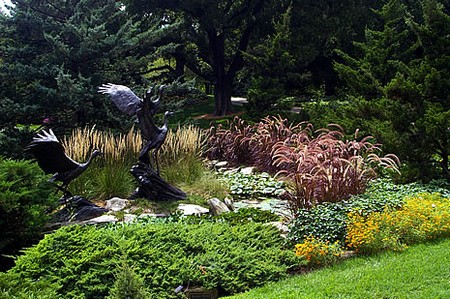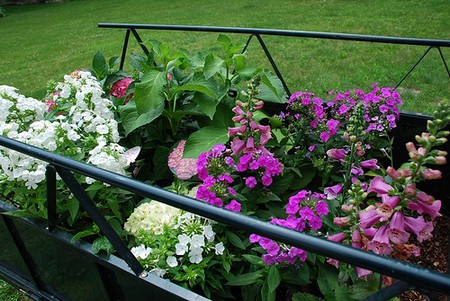Best Way to Consider the Height of Garden Plants
You don’t want to be conscious of how the plants are arranged; all you want is the impression of a community of flowers, beautifully and naturally grouped. Of course you’re going to be guided to some extent by relative height; you wouldn’t plant a solid clump of three-foot phlox in front of a delicate columbine only fourteen inches high. But there’s a lot more to placing a plant than knowing how tall it is.
You need to consider what a plant’s height consists of. Compare, for example, two late-summer beauties, both of which could legitimately be listed in a catalog as “tall, 5 feet.” Boltonia asteroides ‘Snowbank’ is a dense five-foot mass of foliage and flowers; the five-foot daylily (Hemerocallis altissima) has a basal fountain of leaves no more than two feet high, and it is only the flowers on their long wiry stems that get up to five feet. Consideration of height alone would suggest the same place in the border for these two, but if you visualize them you will see that their form is every bit as important as their actual height in deciding where to place them.
Now think of some tall plants with delicate flowers and picture them not to the rear of the bed but right down at the front, to give the border an extra dimension. I like to use Russian sage (Perovskia atriplicifolia) in this way, also some of the tallest coralbells (Heuchera sanguined) because both have airy movement in the slightest breeze, and have flowers and stems insubstantial enough to reveal other plants behind them. These delicate plants can do a lot for such sturdy but prosaic midborder plants as perennial cornflower, sweet William, and Canterbury bells, which gain a little poetry when glimpsed through the veils.
And what about the short plants, so often automatically placed at the front of the border? Is height—or lack of it—the sole criterion? Again, I think form is just as important. As I write, I’m visualizing a part of the front of my border that I find especially pleasing. There are little mounds of thrift (Armeria maritima) and small cushions of ‘Silver Mound’ (Artemisia schmidtiana ‘Nana’) softening a front edge that would otherwise be uncompromisingly straight.
Plants which, though short, do not have this rounded plump shape are not nearly as attractive in this position. There is a dwarf balloon flower, ‘Apoyama’, a mere nine inches tall, whose height certainly qualifies it for the front, and a dwarf phlox, ‘Pinafore Pink’, that’s even shorter, yet their form is wrong. Each of these plants carries its flowers on what looks like a bunch of stiff, erect stems, and neither does what I want for that front edge. But a much bigger plant— Nepeta x faassenii ‘Six Hills Giant’—does. This big catmint, thirty inches or taller, planted in an awkward place where there is a ninety-degree corner to the border, billows out, turns the corner, as it were, and effectively conceals the sharp angle. The eye notes, and the mind receives with pleasure, the small surprise occasioned by the change in height.
Categories
Advertisements
Recent Articles
 How to Understand Bed Sizes – A Small Guide
How to Understand Bed Sizes – A Small Guide How to Select Some Must Have Kitchen Accessories
How to Select Some Must Have Kitchen Accessories Best Way to Change a Car Tire
Best Way to Change a Car Tire Best Way to Write an Affirmation
Best Way to Write an Affirmation Best Way to Take Charge of Your Financial Life
Best Way to Take Charge of Your Financial Life Best Way to Survive a Party When You Don’t Know Anyone
Best Way to Survive a Party When You Don’t Know Anyone Best Way to Stop Self Sabotaging Yourself
Best Way to Stop Self Sabotaging Yourself Best Way to Start Journal Writing
Best Way to Start Journal Writing Best Way to Speak with a Powerful Voice
Best Way to Speak with a Powerful Voice Best Way to Simplify Your Life
Best Way to Simplify Your Life Best Way to Respond to a Put-Down
Best Way to Respond to a Put-Down Best Way to Reduce Acne Breakouts
Best Way to Reduce Acne Breakouts Best Way to Recover from Dining Disasters
Best Way to Recover from Dining Disasters Best Way to Quit Your Job Gracefully
Best Way to Quit Your Job Gracefully Best Way to Make Your Own Website
Best Way to Make Your Own Website



Leave a Reply